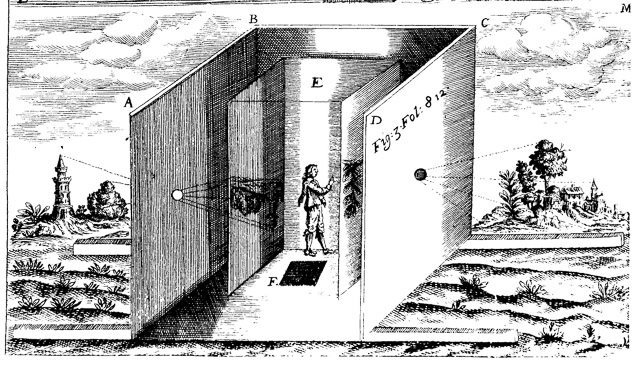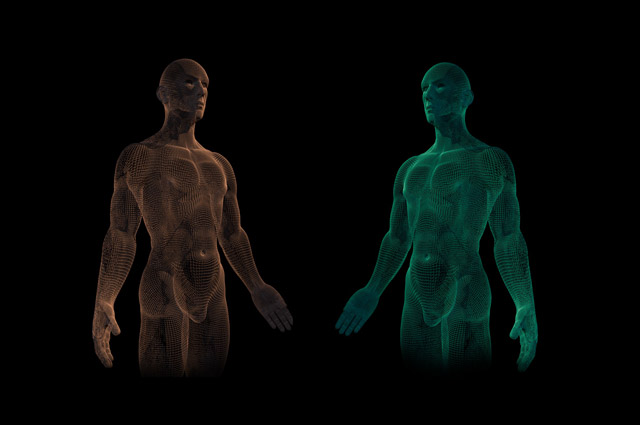Text: Angela Krewani | Section: On ‚Art and Science‘
Since media are often applied in scientific and artistic processes, this essay offers an insight into joined features and hidden relationships between visual media such as photography, film, television and interactive animation and their possible applications in science and art. As early as 1973 media artist and scholar Douglas Davis pointed to the traditional interdependence between art and technology, which from his point of view had emerged in Early Modernism and had been furthered throughout the Industrial Revolution into modern and avant-garde art. The landscape as artistic motive had been replaced by technology as artistic motive (Davis, 1973), having been manifested within the dynamic connection between media and specific forms of communication of media and art. On this account, the artistic practice with media is always attached to technical forms of communication and mass media. Already the central perspective, being generally accepted as artistic and realistic means of ‘true’ perception, operates as technology of the visible purposing to transform the three-dimensional world into the two-dimensional flat space of a drawing, painting or screen.

Against this background the meaning of Dürer’s illustration Der Zeichner der Perspektive (Draughtsman Making a Perspective Drawing of a Reclining Woman) is to be comprehended: the drawing presents the image of a lying nude woman, being measured by a geometrical matrix, which hints at the similar perception of the means of representation and the object itself and it similarly explores the relationship between media disposition and iconic form (Böhm, 1999, p. 170). This visual tradition underlines the impact of the central perspective, which had been picked up on and furthered by other, technologically more up to date media such as photography, film and television. The visual constructions of these media are mainly generated on the grounds of the central perspective, which lets media scholar Peter Gendolla argue that the central perspective has entered art and cultural history as a “symbolic form of thinking” and at the same time structured “contemporary visual spaces” (Gendolla, 2001, p. 20, translated by the author). It however remains a mental construction chained to historical and contemporary images (ibid, p. 20, translated by the author). This adaptive conflation of mathematics and visual representation is described by the art historian Erwin Panofsky as a “structural abstraction from the psychophysiological space […] and a transformation of the psychophysiological space into a mathematical structure” (Panofsky, 1974, p. 101, translated by the author). Because of its transitory features, the central perspective is labelled ‘medium’ by Peter Gendolla (Gendolla, 2001, p. 21). What seems to be a ‘natural perception’ is a subtle construction of visual and technological media, which has to be further explained. At this point the philosopher Gottfried Böhm argues that the central perspective functions as a medium for the “implementation of facts” (Böhm, 1999, p. 172). From this can be followed that the central perspective, being far from a neutral tool, acts in the interest of rational aesthetics which creates “exemplary analogies” to the visual world in order to “bring about a rationalisation which conflates the real seeing with the seeing of a represented reality” (ibid, p. 172). Thus rationality, understood as the basis of modern science, exceeds being a visual attitude in favour of being conceived as a dynamic relationship between visual structures and complex practices, which constitute and transform it. In this way, the interdependence between art and science is characterised by an implicit and stable relationship which governs the visual adaptation of reality – either ‘artistic’ or ‘scientific’. As a consequence of this relationship the technological media film and television developed, adopting the rational structure of the central perspective into their visual structures. Contrary to film, whose mode of operation consists in the after-image, thus the exposure of light into the eye and the generated illusion of movement (Crary, 1990, p. 129), photography is based on the structural continuation of the camera obscura.

This apparatus trusses the light through a lense and transports it into a dark room, letting the shapes of outward objects appear at its walls. Through continuing the perceptive model of the camera obscura, photography distanced itself from the direct impact on the human eye. Contrary to the illusory perception of film, photography enhanced its mimetic features in turning to documenting outside realities. Thus, it could make use of the reality-effects of the central perspective (Latour 1990) and integrate it in its documentary endeavours. In the course of this development, photography turned into a central visual tool in the natural sciences, the military world and within law, and it was further developed within these fields. Due to its different usages and epistemic status, film and photography experienced different applications within scientific processes and documentations. Lorraine Daston and Peter Galison contend that photography played an eminent role within the wish for mechanical objectivity, which emerged in the 19th century, photography participated in documenting scientific processes (Daston and Galison, 1992). Scientific research used photography from its beginnings on, as – among others – the works of Robert Koch demonstrate, who uses photographies as basis for his research on bacteria (Hennig, 2004). Equally important and probably better known are the experiments in the context of social anthropology, whose researchers tried to map and document forms of social behaviour in order to classify it. The rapid integration of photography is striking yet easy to understand. Photography was more than helpful in “documenting” socially deviant behaviour: As early as in 1850 Hugh Welch Diamond had produced his most important works during his time as superintendent of the Female Department of the Surrey County Lunatic Asylum. At the same time Martin Charcot and Paul Richert started their photographic documentation of the “abnormal” at the Salpetrière in Paris (Zielinski, 2002, p. 239). The institutionalisation of photographic documentation in the disciplines medicine, psychiatry and the social sciences corresponds with its acceptance within the former legal system.
The significance of photography within legal processes is inspected by Tal Golan, especially the value of photography as visual evidence. According to Golan this happened in 1852, when the legal use of photography was firstly mentioned by the American Photographic Journal. The journal reported of “daguerrotypes”, which were presented by lawyers in order to convince the judges better than with words (Golan, 2002, p. 172). Based on this development, later even more advanced visual evidence was accepted as legal document, this augmentation of evidentiary material referred to the multiple and rapidly developing visual technologies such as x-ray images and other technologies, which can be subsumed under the term “radiology”. Having been accepted as evidence within the legal system, it shifted into other social and cultural forms, apparently offering a reason and cause for all kinds of injuries. Another consequence of the corresponding acceptance of photography in medical and legal contexts is the emergence of the “scientific” criminal anthropology.
This development can be understood on grounds of the biography of Cesare Lombroso, who had been practicing as professor for forensic medicine and psychiatry, before he started teaching in the newly established discipline of criminal anthropology. Within this research photography played an eminent role, it functioned as analytical instrument and archive at the same time (Zielinski, 2002, p. 241f). These features of photography, especially the attributed objectivity, branch out into film, which sharpens the dissecting and classificatory gaze. Charles Muybridge’s and Edgar Marey’s chronophotographies function as a transition between photography and film, recording non-perceptible movements. Subsequent filmic methods of visualising were developed in the disciplines of biology and physics basing on the filmic features of bringing about the illusion of movement (Curtis, 2005; Landecker, 2005; Kelty, 2004). These features are the documentation of movements and structures, which are invisible to the eye and which – being recorded on film – could be transferred into the scientific discourse. Thus, Scott Curtis manages to bring forth that within physical research the movements of electrones – the Brownian movement – was invisible to the human eye, but it could be caught on film. In this way film was responsible for the constitution of scientific knowledge and – similarly – served as scientific instrument. Facing the significance of scientific recording, Brian Winston uses the term ‘scientific inscription’, a practice, which transmits laboratory’s instrumental data into visual and textual documents thus providing their visibility. The scientific instruments fall together with the inscription device: “This perturbation, invisible in the chamber, is visible on paper; the chemical, no matter what it is, is given shape on paper” (Winston, 1993, p. 41). Winston compares observing-positions in the laboratory and the work with the instruments of recording and inscription with the documentary film camera as instrument of inscription as well: “The camera is no more and no less than a device for representing the world of natural phenomena, a device like any other […] instrument” (ibid., p. 41f). According to Winston especially the American documentary film of the ‘direct cinema’, lacking any voice-over, represents the cinematographic form of the scientific approach towards social and political events. Comparable to the scientific use, the camera operates as dissecting, scientific tool as well, as he remarks: “With this equipment they can approximate quite closely the flexibility of the human senses” (ibid., p. 43) These remarks bring about the connection of a popular, journalistic form of the documentary film with the practices of scientific inscription.
Hopefully this few examples could convey an idea of the multifarious connections and associations of the visual media within scientific and artistic processes. From their beginnings on, these media were applied within scientific practices, whereas the limit between art and sciences was often fluctuating. These observations could be furthered into contemporary scientific processes and supported by various examples. On the level of a structural correlation between science and art it should be stated that the proximity of science and art is not an ontological fact, but it is continually produced by the use of their mutual instruments.
Featured image above text: Max Pixel: Symmetry Darkness Contrast Mirroring Dark Black. CC0 1.0 Universal.
Click here for biographical details on the author.
Böhm, Gottfried. 1999. “Vom Medium zum Bild.” In: Bild-Medium-Kunst, Ed. Yvonne Spielmann and Gundolf Winter, 165–77. München: Fink Verlag.
Crary, Jonathan. 1990. Techniques of the Observer: On Vision and Modernity in the Nineteenth Century. Cambridge, Mass.: MIT Press.
Curtis, Scott. 2005. “Die Kinematographische Methode. Das ‘bewegte Bild’ und die Brownsche Bewegung.” In: montage a/v 14, no. 2: 22–43.
Daston, Lorraine, and Peter Galison. 1992. “The Image of Objectivity.” In: Representations 40: 81–128.
Davis, Douglas. 1973. Art and the Future. History/Prophecy of the Collaboration Between Science, Technology and Art. London: Thames and Hudson.
Gendolla, Peter. 2001. “Zur Interaktion von Raum und Zeit.” In: Formen interaktiver Medienkunst, Ed. Peter Gendolla et.al, 19-38. Frankfurt am Main: Suhrkamp.
Golan, Tal. 2002. “Sichtbarkeit und Macht: Maschinen als Augenzeugen.” In: Ordnungen der Sichtbarkeit. Fotografie in Wissenschaft, Kunst und Technologie, Ed. Peter Geimer, 171–210. Frankfurt am Main: Suhrkamp.
Golan, Tal. 2004. “The Emergence of the Silent Witness: The Legal and Medical Reception of X-Rays in the USA.” In: Social Studies of Science 34, no. 4: 469–99.
Hennig, Jochen. 2004. “Vom Experiment zur Utopie. Bilder in der Nanotechnologie.” In: Bildwelten des Wissens. Kunsthistorisches Jahrbuch für Bildkritik 2, no. 2: 9–18.
Kelty, Christopher, Landecker, Hannah. 2004. “A Theory of Animation: Cells, L-Systems, and Film.” In: Grey 17: 31–63.
Kittler, Friedrich. 2010. Optical Media: Berlin Lectures 1999. Cambridge, UK; Malden, MA: Polity.
Landecker, Hannah. 2005. “Cellular Features: Microcinematography and Film Theory.” In: Critical Inquiry 31, no. 4 (Summer): 903–37.
Latour, Bruno. 1990. “Drawing Things Together”. In: Representation in Scientific Practice, Ed. Steve Woolgar and Michael Lynch, 16–68. Cambridge: MIT Press.
Panofsky, Erwin. 1974. “Die Perspektive als Symbolische Form (1924).” In: Aufsätze zu Grundfragen der Kunstwissenschaft, Ed. Hariolf Oberer and Egon Verheyen, 99–168. 2. Aufl. Berlin.
Zielinski, Siegfried. 2002. Archäologie der Medien. Zur Tiefenzeit des technischen Hörens und Sehens. Frankfurt am Main: Rowohlt.
How to cite this article
Angela Krewani (2018): The Aesthetic Imprint of Technological Images. w/k–Between Science & Art Journal. https://doi.org/10.55597/e2820


Be First to Comment